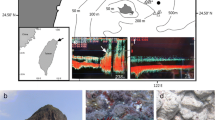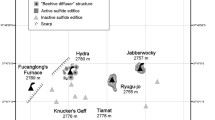Abstract
Larvae of benthic invertebrates collected in the water column above Juan de Fuca Ridge show distinct variations in abundance and composition in, and away from, the neutrally-buoyant hydrothermal plume emanating from underlying vents. Larvae of vent gastropods (Lepetodrilus sp. and two peltospirid species) occur in significantly higher abundances in the plume than away from it (mean abundance=21.0 individuals 1000 m−3 vs 1.4 individuals 1000 m−3), and larvae of vent bivalves (Calyptogena? sp.) occur exclusively in the plume (mean abundance=0.5 individuals 1000 m−3). Larvae from other benthic taxa known not to be endemic to Juan de Fuca vent communities, such as anthozoans, pholad clams, bryozoans and echinoderms, are less abundant in the plume than away (mean abundance=47.5 vs 16.9 individuals 1000 m−3) at comparable depths and heights above the bottom. These results support the hypothesis that larvae of vent species are entrained into buoyant hydrothermal plumes and transported at the level of lateral spreading several hundred meters above the seafloor. The discovery of vent-associated larvae in the plume suggests that models used to predict hydrodynamic processes in the plume will also be useful for modeling larval dispersal. Advanced imaging and new molecular-based approaches will be required to resolve taxonomic uncertainties in some larval groups (e.g. certain polychaete families) in order to distinguish vent species and make comprehensive flux estimates of all vent larvae in the neutrally-buoyant plume.
Similar content being viewed by others
References
Ahlstrom EH, Thrailkill JR (1963) Plankton volume loss with time of preservation. Rep Calif coop ocean Fish Invest 9:57–73
Baker ET (1990) Hydrothermal plume prospecting: hydrographic and geochemical techniques. In: McMurray GR (ed) Gorda Ridge. Springer-Verlag, New York, pp 155–167
Baker ET, Massoth GJ (1987) Characteristics of hydrothermal plumes from two vent fields on the Juan de Fuca Ridge, northeast Pacific Ocean. Earth planet Sci Lett 85:59–73
Berg CJ, Van Dover CL (1987) Benthopelagic macrozooplankton communities at and near deep-sea hydrothermal vents in the eastern Pacific Ocean and the Gulf of California. Deep-Sea Res 43:379–401
Burd BJ, Thompson RE, Jamieson GS (1992) Composition of a deep scattering layer overlying a mid-ocean ridge hydrothermal plume. Mar Biol 113:517–526
Cannon GA, Pashinski DJ, Lemon MR (1991) Middepth flow near hydrothermal venting sites on the southern Juan de Fuca Ridge. J geophys Res 96:12815–12831
Chia FS, Buckland-Nicks J, Young CM (1984) Locomotion of marine invertebrate larvae: a review. Can J Zool 62:1205–1222
German CR, Sparks RSJ (1993) Particle recycling in the TAG hydrothermal plume. Earth planet Sci Lett 116:129–134
Haymon RM, Fornari DJ, Von Damm KL, Lilley MD, Perfit MR, Edmond JM, Shanks III WC, Lutz RA, Grebmeier JM, Carbotte S, Wright D, McLaughlin E, Smith M, Beedle N, Olson E (1993) Volcanic eruption of the mid-ocean ridge along the East Pacific Rise crest at 9°45–52'N: direct submersible observations of seafloor phenomena associated with an eruption event in April, 1991. Earth planet Sci Lett 119:85–101
Haymon RM, Koski RA, Sinclair C (1984) Fossils of hydrothermal vent worms from Cretaceous sulfide ores of the Samail Ophiolite, Oman. Science, NY 223:1407–1409
Helfrich KR, Battisti TM (1991) Experiments on baroclinic vortex shedding from hydrothermal plumes. J geophys Res 96: 12,511–12,518
Hessler RR, Smithey WM, Boudrias MA, Keller CH, Lutz RA, Childress JJ (1988) Temporal change in megafauna at the Rose Garden hydrothermal vent (Galapagos Rift; eastern tropical Pacific). Deep-Sea Res 35:1681–1709
Kim SL, Mullineaux LS, Helfrich KR (1994) Larval dispersal via entrainment into hydrothermal vent plumes. J geophys Res 99: 12655–12665
Lutz RA (1988) Dispersal of organisms at deep-sea hydrothermal vents: a review. Oceanol Acta (Spec Vol): 23–29
Macdonald KC (1982) Mid-ocean ridges: fine scale tectonic, volcanic and hydrothermal processes within the plate boundary zone. A Rev Earth planet Sciences 10:155–190
Mullineaux LS, Kim SL, Pooley A, Lutz RA (1995) Identification of archaeogastropod larvae from a hydrothermal vent community. (in preparation)
Mullineaux LS, Wiebe PH, Baker ET (1991) Hydrothermal vent plumes: larval highways in the deep sea? Oceanus 34:64–68
Olson RR, Runstadler JA, Kocher TD (1991) Whose larvae? Nature, Lond 351:357–358
Pearse JS, McClintock JB, Bosch I (1991) Reproduction of Antarctic bentic marine invertebrates: tempos, modes and timing. Am Zool 31:65–80
Scheltema RS (1986) On dispersal and planktonic larvae of benthic invertebrates: an ecletic overview and summary of problems. Bull mar Sci 39:290–322
Sokal RR, Rohlf FJ (1969) Biometry. The principles and practice of statistics in biological research. W.H. Freeman & Co., San Francisco
Speer KG (1989) A forced baroclinic vortex around a hydrothermal plume. Geophys Res Lett 16:461–464
Tunnicliffe V (1991) The biology of hydrothermal vents: ecology and evolution. Oceanogr mar Biol A Rev 29:319–407
Weikert H, Koppelmann R (1993) Vertical structural patterns of deep-living zooplankton in the NE Atlantic, the Levantine Sea and the Red Sea: a comparison. Oceanol Acta 16:163–177
Wiebe PH (1988) Functional regression equations for zooplankton displacement volume, wet weight, dry weight, and carbon: a correction. Fish Bull US 86:833–835
Wiebe PH, Boyd S, Cox JL (1975) Relationships between zooplankton displacement volume, wet weight, dry weight, and carbon. Fish Bull US 73:777–786
Wiebe PH, Copley N, Van Dover CL, Tamse A, Manrique F (1988) Deep-water zooplankton of the Guaymas Basin hydrothermal vent field. Deep-Sea Res 35:985–1013
Wiebe PH, Morton AW, Bradley Am, Backus RH, Craddock JE, Barber V, Cowles TJ, Flierl GR (1985) New developments in the MOCNESS, an apparatus for sampling zooplankton and micronekton. Mar Biol 87:313–323
Wishner KF (1980) Aspects of the community ecology of deep-sea benthopelagic plankton, with special attention to gymnopleid copepods. Mar Biol 60:179–187
Young CM, Cameron JL (1987) Laboratory and in situ flotation rates of lecithotrophic eggs from the bathyal echinoid Phormosoma placenta. Deep-Sea Res 34:1629–1639
Author information
Authors and Affiliations
Additional information
Communicated by N.H. Marcus, Tallahassee
Rights and permissions
About this article
Cite this article
Mullineaux, L.S., Wiebe, P.H. & Baker, E.T. Larvae of benthic invertebrates in hydrothermal vent plumes over Juan de Fuca Ridge. Marine Biology 122, 585–596 (1995). https://doi.org/10.1007/BF00350680
Received:
Accepted:
Issue Date:
DOI: https://doi.org/10.1007/BF00350680




